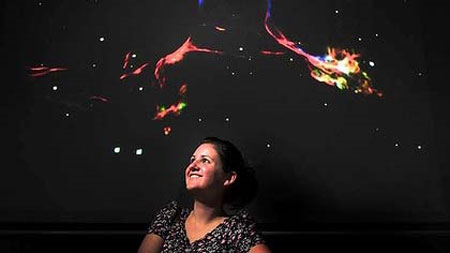Mysterious decoding student used to be an astronomer
The Australian female student has proved a mystery that astrophysicists have been searching for over the past few decades.

Amelia Fraser-McKelvie in a wonderful internship in her life.
(Photo: Sydney morning heral d).
The summer internship for astrophysics has become a great breakthrough in the science of a college student, Amelia Fraser-McKelvie. Amelia is a student at Monash University - Australia, she helped solve one of the great mysteries of science.
It is about discovering what so far is understood to be the 'masses of missing' (Universe's missing mass) of the universe . Amelia is working with the Monash University physics research team, has done a study of X-rays on matter and has come to the results of the study.
For a long time, astrophysicists still have a significant obstacle when it comes to believing that the universe must contain a greater mass than what is known from planets, dust particles and stars, they make so most of the material is visible.
Yet they have no way to prove it. In order for the universe to exist and operate, according to astronomers' calculations, about half of the required mass is' missing '(ie invisible). Observing X-rays can see important information of the physical properties of large-scale structures, which helps astrophysicists better understand the nature of nature.
It is worth noting that Fraser-McKelvie is not a professional researcher or even a doctoral student. She is just a 22-year-old student, studying cosmology and working under the guidance of two astronomers, Dr. Kevin Pimbblet and Dr. Jasmina Lazendic-Galloway, in internship with a summer scholarship. now on. Amelia solved this problem in a very simple way.
Dr. Pimbblet said that the invention is put in the context of scientists actively hunting for the 'missing mass' of the universe for decades, and therefore it is very important. Amelia was surprised to find this, at first, she did not realize that she had found the 'missing mass'. After presenting his findings to Dr. Lazedic-Galloway, it became clear.

From left: Dr. Jasmina Lazendic-Galloway, Amelia Fraser-McKelvie and PhD
Kevin Pimbblet. (Photo: Monash School ).
All three published a paper on defective mass in one of the world's oldest and most prestigious scientific journals, the Royal Astronomical Society (Monthly Notices of the Royal Astronomical Society).
As for Amelia, she said: 'As the author of a published work is a very interesting thing for me, I could not achieve this without the help of Kevin and Jasmina. Their passion and dedication to this research project created a great result and I am very grateful to them for all the help for me and the time they invested . '
Currently, Fraser-McKelvie is continuously praised as one of the best young students. Dr. Pimbblet said that he is leading a very talented student in conducting groundbreaking research.
' She has published a work on one of the highest ranked astronomy journals in the world and that is the result of her efforts. I cannot emphasize the importance of such a great achievement. We will use this research as a scientific driver for making future telescopes that are being planned, 'Dr. Pimbblet said eagerly.
- Uncover mysterious figures in China
- Decoding alien signals 40 years ago
- Astronomer launched Apollo 10 spacecraft search
- Decode the premonition from the 9 most frequent dreams of man
- Decode the content of the 800-year-old character
- Answer the mysterious structure in the Amazon forest
- Decode cheap DNA
- Mysterious decoding of green light on the Gulf of Thailand
- Mysterious decoding of strange ice holes constantly appearing in Antarctica for decades
- Finding the remains of astronomer Copernicus
- Hell hole in Russia Bermuda triangle decoding
- New DNA technology decodes mysterious deaths
 Van Allen's belt and evidence that the Apollo 11 mission to the Moon was myth
Van Allen's belt and evidence that the Apollo 11 mission to the Moon was myth The levels of civilization in the universe (Kardashev scale)
The levels of civilization in the universe (Kardashev scale) Today Mars, the sun and the Earth are aligned
Today Mars, the sun and the Earth are aligned The Amazon owner announced a secret plan to build a space base for thousands of people
The Amazon owner announced a secret plan to build a space base for thousands of people